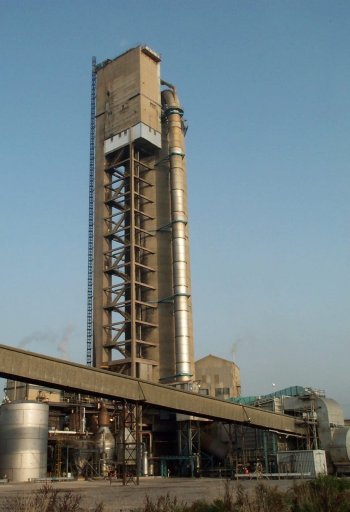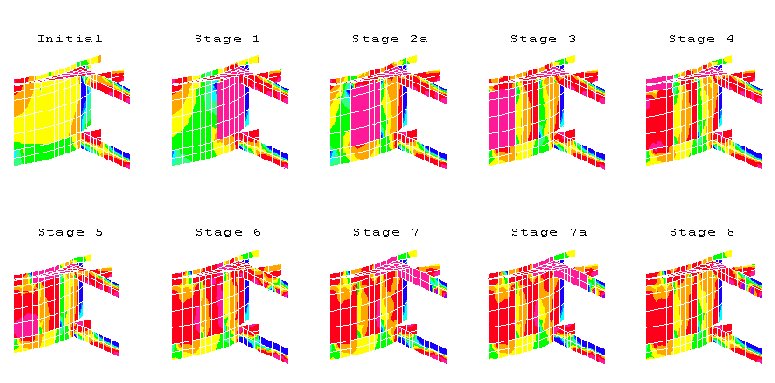Case Study
Modelling the replacement of degraded concrete on the Terra Nitram
prill tower
-
Complex concrete refurbishment work
-
Global modelling of tower to assess areas of high stress
concentrations
-
Local modelling of staged construction analysis using 'Birth and
Death' elements
| The Severnside prill tower
was operated by Terra Nitrogen (UK) Ltd to manufacture ammonium nitrate fertiliser. Despite
a history of regular maintenance and repair, parts of the reinforced concrete structure
deteriorated over the years due to the severe operating environment,
and eventually significant structural repairs were required. ABB formulated an outline repair strategy
and design and technology consultants Taylor
Woodrow were appointed undertake the complete project management including the design
and supervision of the remedial works.
Taylor Woodrow chose to use LUSAS Civil &
Structural to assist with the complex task of modelling the demolition and
re-construction sequences to replace the degraded concrete in the tower whilst keeping the
plant operational throughout.
History
The tower was constructed in 1964. It consists of a 86m high, 15.6m
diameter drop shaft of 178mm thickness. A five storey reinforced concrete plant house,
supported on the drop shaft, a lift shaft and a single braced column, forms the upper 75m
to 100m levels. Despite protective measures being undertaken during its construction a
number of concrete repairs have had to be made during the tower’s life.
|

|
Global
modelling
Prior to the detailed staged construction design a LUSAS analysis of the complete
structure was undertaken for dead, plant, circulation and wind loads to assess the
structural behaviour of the tower both in its as-built and current deteriorated condition
for checking with relevant design codes. Fine mesh divisions were used in areas of repair
and coarse mesh divisions used in areas remote from the plant house.
Results from the as-built model confirmed the behaviour of the structure and identified
areas where high stresses could be expected. Results from the model incorporating reduced
modulii of elasticity for all areas of degradation showed how initial as-built forces had
redistributed due to the ammonium nitrate attack and indicated an even more urgent need
for the remedial work to be undertaken. This latter analysis also proved extremely useful
in deriving subsequent repair sequences. In all, over 100m2 of drop shaft wall and damaged
areas of beams, columns, slabs and walls for a number of levels of the plant house
required replacing.
The LUSAS birth and death facility
The complex sequence of structural repairs was modelled in LUSAS using the birth and
death facility. This allows elements to be de-activated to simulate areas of concrete
removal, resulting in stress redistribution in the model. Following repair, the elements
are re-activated with corresponding new material properties. In this manner a structural
assessment was undertaken for all stages of the repairs to the tower including the use of
major temporary works such as support frames, props and jacks to ensure the structure
remained safe at all times.
Modelling of the staged repair sequences
While some local patch repairs were necessary at the lowest level of the plant house
the areas requiring most extensive repairs were between level 5 and the roof at 100m
level. Each level of the plant house presented different problems and required appropriate
repair sequences and temporary support arrangements. At each stage of the repair sequence
the forces in both temporary props and the support frame and the walls, columns, beams and
floor slabs of the plant house were examined in LUSAS to ensure the structure remained
safe. For the temporary support frame calculated deflections were compared with on-site
measurements to ensure nothing unexpected was happening. In general, good correlation was
achieved confirming the validity of the LUSAS modelling and design calculations.

Previous patch repairs to the drop shaft wall had
indicated that such repairs should be undertaken by a staged replacement of alternate
panels not exceeding of 1m x 2m in area. However, by using appropriate temporary works
including jacking, LUSAS confirmed that considerably larger areas could be broken out and
repaired in a single operation.
"Adopting the 'birth and death' technique
in the LUSAS analyses gave us a high degree of confidence that the structure would remain
safe at all times. This was of prime importance as the plant had to remain operational
thoroughout the duration of the repair contract."
Graham Anderson, Taylor Woodrow
Find out more
Other LUSAS Civil &
Structural case studies:
|